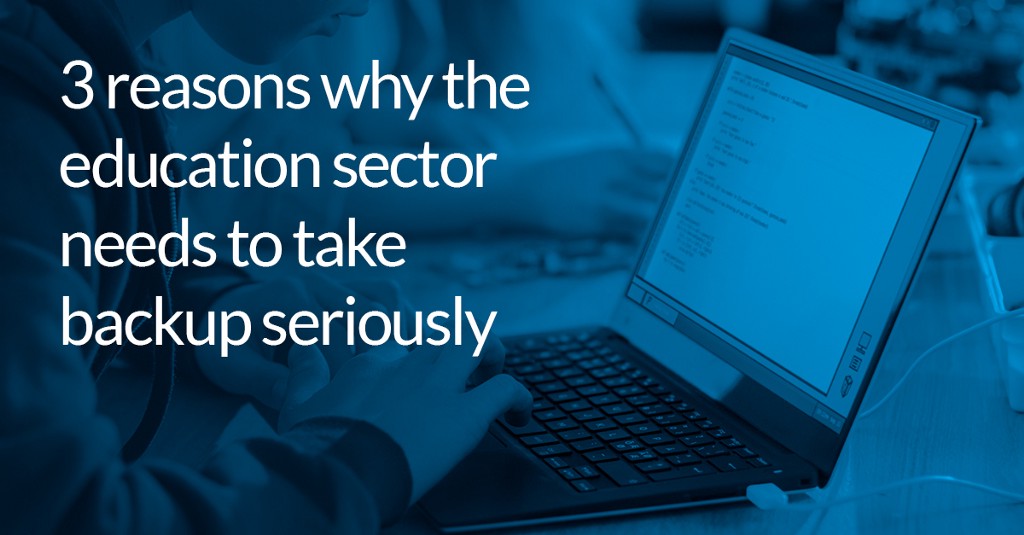3 reasons why the education sector needs to take backup seriously

Digital transformation has been instrumental in improving educational experiences for millions of people around the world. But while increased digitization has helped to power innovation, it brings with it new risks. These range from cyberattacks to unpredictable hardware failures — and while they all have unique causes and require a certain degree of attention separate from one another, robust and reliable backup can go a long way in helping to mitigate and minimize these vulnerabilities.
Indeed, backup should be part of a wider IT strategy in which competing interests and priorities are all managed in a balanced manner. On its own it might seem like a minor part of your IT portfolio — but without it, all your efforts to improve cybersecurity and system resilience could be wasted.
Here are a few reasons why backup is essential for education institutions at all levels.
Schools and universities are prime targets for cybercriminals
There are many different reasons why education establishments are targeted by cybercriminals. However, most of these come down to 2 things — the wealth of data available (on students, alumni, even staff), and the fact such institutions are particularly weak on security (a 2018 report by Security Scorecard placed the education sector as one of the worst performing in a number of cybersecurity domains).
Moreover, with a widely distributed range of networks used by different departments, courses, and individual classes, and an even larger number of devices being used across campuses, there are many points of vulnerability that can be exploited.
Of course, backup can’t solve these problems alone. Mitigating these risks requires a sustained and strategic cybersecurity initiative that would be complex in any setting, least of all a large education institution. But backup forms a fundamental line of defence in that strategy. It gives everyone — from administrators to teaching staff through to students — the confidence that should the worst happen, information and data can be recovered and restored.
The number of ransomware attacks on education institutions is a good microcosm of the wider threat of cybercrime.
Modern education is built on reliable, and available data
The Coronavirus pandemic is teaching every sector many challenging lessons in remote working — education included. Having access to resources, information and data — on both the student and staff side — is integral in allowing many institutions to have any semblance of normal functioning.
But even outside of the current pandemic, modern education has — for many years — thrived on reliable and available data. It takes some of the friction out of administration, it allows educators to deliver better experiences for students, and, for students, it allows them to get more out of their education too.
This is, in fact, another reason why such establishments are targeted by cybercriminals. The growth of ransomware attacks on universities and schools, for example, is unfortunately so effective because data recovery and retrieval is essential for business as usual. It’s why the University of Calgary paid CA$20,000 to criminals to regain control of its ransomed systems, and why Los Angeles Valley College paid $28,000 to attackers. Indeed, with education budgets so tight, it leaves institutions between a rock and a hard place.
This means that protecting it — ensuring that it can be recovered quickly and easily — is absolutely essential. It’s also something that will matter to just about everyone in an education setting. Put simply, backup benefits all stakeholders.
Power outages and other prosaic problems
We’ve seen above that backup is essential for managing both high-tech risks and leveraging high-tech advantages.
But even mundane power outages can cause serious issues in terms of data loss. To a certain extent this is more pronounced for small schools with tight budgets and limited infrastructure, but the risk is there for every type of institution.
A natural disaster, weird weather or just a plain old power outage: all of these things won’t only wreak physical havoc, they could completely upend your valuable data. True, this might seem like a small consideration, particularly when staff and student safety will be a priority, but, if you don;t have backup in place, it does add an additional layer of complexity and stress to an already difficult situation.
Using backup in practice in an education setting
The fundamental reasons why educational institutions should take backup seriously are the same for all — whether you’re a primary school or a postgraduate college. But each establishment will have their own unique circumstances — from their existing infrastructure to current security challenges.
The University of Leicester provides a good case study in how backup can be used by educational institutions. Mark Penny, the university’s IT department system specialist, brought Macrium to the institution off the back of his own experience with the product all the way back in 2010. For a decade, it has been used by the IT department to protect their environment and infrastructure — while it may remain invisible to many at the university, it has been an integral part in helping the University of Leicester continue to deliver high-quality education to thousands of students.
Penny notes a number of particular features — all of which speak to the overall need for greater protection against rising cyberattacks, and the ability to recover and restore quickly.
For example, Macrium’s support for bare metal recovery is particularly valuable to the University IT department. “In the event that we lost a data centre” Penny explains, “I will need to be able to get my environment back quickly.”
He also speaks highly of Macrium’s Image Guardian features, which protects backup files from ransomware. “I really like Macrium Image Guardian: It’s certainly worth installing Macrium Reflect on your storage server to provide protection of your backup images… they effectively are your get-out-of-jail-free card.”
Read the University of Leicester case study here.
Conclusion: Backup is essential for a world where the future of education is digital
Cybersecurity threats aren’t going to disappear. If anything they’re only going to grow in number. But this doesn’t mean we should turn our back on digital transformation in the education sector. Instead, we simply need to become smarter in how we protect our systems and mitigate the very real risks that are out there.
Backup is only a small part of that, but it’s nevertheless essential. Without it’s impossible to have 100% confidence that your institution can manage disaster — most importantly, without it students can’t rely on you for a high teaching and support.
Explore Macrium’s range of backup solutions trusted by education insitutions all around the world.


